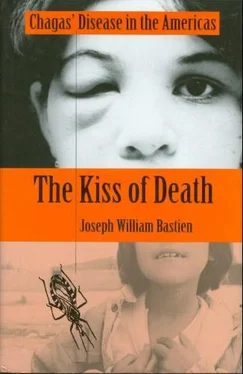“I didn’t sleep at all,” he replied. When I asked why, he continued. “I refused to sleep. I chased vinchucas from my body. I didn’t want them to bite me!” When I asked what vinchucas were, he told me that they cause Chagas’ disease. He was not afraid of malaria and syphilis, but he dreaded Chagas’ disease. He explained what this disease was, and, for the first time in my life, I questioned the potential price of a good night’s sleep. Having lived years in peasants’ huts, I realized that I had long been at risk and wondered why no one had advised me about Chagas’ disease. Even today, Chagas’ disease remains unknown to many educated people and doctors throughout the world. Tropical diseases in impoverished countries receive little recognition and research, primarily because biomedical technology and pharmaceutical companies concentrate on wealthier clientele in temperate zones of industrial countries. The doctor’s final comments were, “Chagas’ disease is a poverty-driven disease.”
Once I began looking for Chagas’ disease, I found it throughout Bolivia. When I was researching Kallawaya herbalists outside of Charazani, Bolivia, they reported increased mal de corazon (heart problems) and muerto subito (sudden death) among their peasants, which seemed strange to them. Andeans living at high altitudes are noted for their strong hearts as well as increased lung capacity. Acute respiratory diseases are major diseases in higher altitudes. Peasants complained of fatigue, somewhat unusual for people accustomed to working above 9,750 feet (3,000 m.). I suspected that Kallawayas were dying of Chagas’ disease, and, not surprisingly, as I later learned, the Kallawaya region is an endemic area of Chagas’ disease.
When I interviewed Kallawaya herbalists about local diseases and plant uses, I found no direct references to Chagas’ disease. This is not unusual, however, because the symptoms of Chagas’ disease are varied and diffuse. I suspected that they were treating the disease’s symptoms, such as fevers, intestinal disorders, and heart problems. One local herbalist, Florentino Alvarez, taught me herbal curing (see Bastien 1987a:9-10). When I met him in 1979 he was paralyzed from a stroke and hardly able to walk and talk. I massaged his legs, gave him vitamins, and helped him along with crutches. As he slowly recovered, he showed me some plants and explained how they were used. Florentino Alvarez died in 1981, of unknown causes, perhaps from Chagas’ disease.
The full impact of Chagas’ disease struck me in November 1990 when I attended a planning session for Chagas’ control in Bolivia. Earlier that year, Paul Hartenberger of the United States Agency for International Development (USAID) and Joel Kuritsky of the Centers for Disease Control (CDC) asked Robert Gelbard, U.S. ambassador to Bolivia, to request monies from President George Bush for prevention of Chagas’ disease in Bolivia. Although the Ministry of Health in Bolivia had been granted $20 million for a child survival program from 1989 to 1994, no monies had been allocated for Chagas’ control. Gelbard asked the newly inaugurated president of Bolivia, Jaime Paz Zamora, to request monies from President Bush when he visited the White House later that year. Bush granted one million dollars to immediately begin a Chagas’ campaign in Bolivia. Later, several million more dollars were added to fund the SOH/CCH Chagas’ control pilot projects.
Kuritsky convened world experts on Chagas’ disease to meet in La Paz, Bolivia, in November 1990 to design a Chagas’ program. He invited me to assist in regard to cultural and social aspects of Chagas’ disease and prevention. After five days of participation in these meetings, I learned about the disease’s epidemic proportions, problems in prevention, and complex nature. Philip Marsden shared with me details of how he had stopped its spread in parts of Brazil. Andy Arata and Bob Tonn of Vector Biology and Control Project (VBC) convinced me that vector control of Chagas’ disease is possible with insecticides and the improvement of houses. Hartenberger, Kuritsky, and Charles Lewellyn led a group of Bolivian epidemiologists, public health workers, and social scientists into accepting the challenge to eradicate Chagas’ disease in Bolivia. War had been declared against the disease, and control of Chagas’ disease was made an important component of the USAID Child Survival Program in Bolivia (CCH), which had a joint program with Secretariat Nacional de Salud (SNS) (see SOH/CCH 1994). [3] 3. The acronym in Spanish is SNS/CCH, Programa Piloto de Control de Chagas; in English it is SOH/CCH, Chagas Control Pilot Project.
We left the workshop with T-shirts and buttons emblazoned with the crossed-circle stamping out an ugly vinchuca bug.
I returned to Bolivia during the summers of 1992, 1994, 1995, and 1997 to observe projects of SOH/CCH that included building new houses and improving hygiene as ways to prevent Chagas’ disease. Their success was limited to the degree that they used education, community participation, cultural sensitivity, and employment of native economic systems. More than 3,000 houses were built by project monies and peasant labor. I observed, however, that building new houses was not economically feasible for the majority of Bolivians, and that people generally were not practicing housing hygiene. As one example, in Aramasi, Department of Cochabamba, peasants resisted improving their houses because they thought that once the houses were improved they would be taken from them. This problem could be confronted by the education and preparation of community members. Another concern was that it is easier to kill bugs with insecticides (the technological quick fix) than to get peasants to maintain their houses and practice housing hygiene. This problem required being culturally and socially sensitive towards peasants, educating them to participate wholeheartedly in Chagas’ control, and assisting them in the maintenance of this control. Pro-Habitat of Bolivia designed posters and videos towards these ends. This book presents some of these successful strategies to prevent Chagas’ disease.
This book contributes to scholarly research by being the only text in English that covers Chagas’ disease in a comprehensive manner. Other monographs concentrate on specific issues; for example, Control of Chagas’ Disease, published in 1991 by the World Health Organization, contains information on epidemiology and vector control. An evaluation study, Chagas Disease in Bolivia: The Work of the SOH/CCH Chagas Control Pilot Program, 1994, describes the results of housing improvement by the national control program in Bolivia.
A landmark study in Spanish, La Casa Enferma: Sociología de la Enfermedad de Chagas by Roberto Briceño-León, 1990, centers upon understanding social processes and human behavior that bring into contact humans, triatomine vectors, T. cruzi, and Chagas’ disease. Briceño’s book provides an analysis of a housing improvement project in Venezuela that served as a guide for the Bolivian control project.
Chagas’ Disease and the Nervous System, published by the Pan American Health Organization in 1994, covers the pathogenesis of Chagas’ disease and supports the theory that morbidity in Chagas’ disease results from misdirected effects of the humoral and cellular immune responses in infected patients, induced by a breakdown of self-tolerance. The involvement of autoimmune mechanisms in the pathogenesis of Chagas’ disease compares it in some ways with AIDS; hopefully, more research on the role of the immune system in both diseases will provide some solutions.
Kiss of Death incorporates findings from these books into an interdisciplinary study that looks at the broader picture of the relationship of Bolivians to this disease. It highlights how they culturally adapt to the disease. As one illustration, when I questioned herbalists about Chagas’ disease, many had not heard about it. They complained about vinchucas biting them at night but had no idea that these trumpet-nosed blood-sucking bugs were bearers of a deadly parasite. However, some herbalists recommended burning eucalyptus leaves to drive out vinchucas. This and other ways that natives have adapted to disease constitute important knowledge. Kiss of Death provides this information.
Читать дальше












